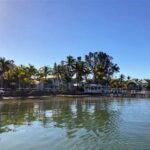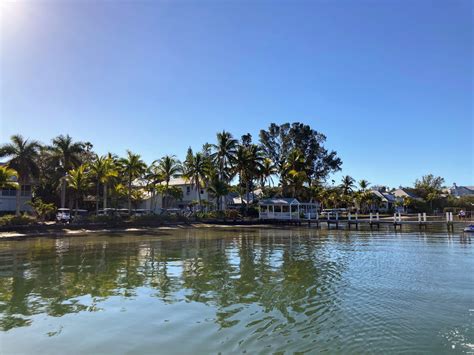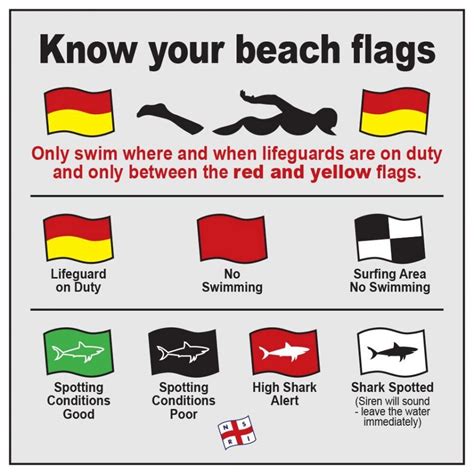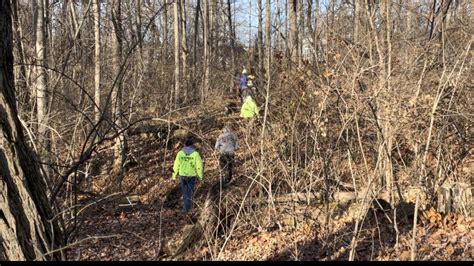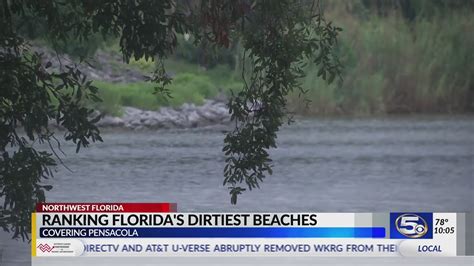
Florida’s Bahia Honda State Park, renowned for its natural beauty, has been flagged as having some of the highest bacteria levels in the state and the nation, according to a recent study by Environment America. The analysis of water quality data revealed alarming levels of fecal bacteria, potentially posing health risks to swimmers and beachgoers.
Bahia Honda State Park recorded unsafe bacteria levels on 53% of the days samples were taken in 2023, according to the Environment America report. This elevated the Florida Keys park to the top of the list for Florida beaches and positioned it among the worst nationwide for high bacteria counts.
The Environment America Research & Policy Center released its annual “Safe for Swimming?” report, analyzing fecal bacteria contamination at nearly 7,400 beaches across the United States. The report draws data from 2023 testing. Fecal bacteria, such as Enterococcus and E. coli, can indicate the presence of human or animal waste, which can carry pathogens that cause illnesses.
“Our ‘Safe for Swimming?’ report shows that bacteria levels at beaches across the country put people’s health at risk,” said John Rumpler, clean water director for Environment America Research & Policy Center.
The report emphasized that fecal contamination can lead to a variety of health problems, including gastrointestinal illnesses, respiratory infections, and skin rashes. Children, the elderly, and individuals with compromised immune systems are particularly vulnerable to these health risks.
The Environment America report did not explicitly state the source of the bacteria contamination at Bahia Honda State Park. However, fecal bacteria pollution can stem from multiple sources, including sewage overflows, stormwater runoff, agricultural runoff, and malfunctioning septic systems. Given Bahia Honda’s location in the Florida Keys, failing or inadequate septic systems may be a contributing factor, along with wildlife and boat discharge.
The Florida Department of Environmental Protection (DEP) conducts regular water quality testing at beaches throughout the state and issues advisories when bacteria levels exceed established safety thresholds. The DEP’s website provides up-to-date information on beach conditions, including any active health advisories.
While Bahia Honda State Park had the highest percentage of days with unsafe bacteria levels, other Florida beaches also showed elevated levels of contamination. The report indicates a broader issue of water quality challenges in Florida and the need for greater investment in infrastructure improvements and pollution control measures.
Beyond Bahia Honda, the Environment America report highlighted that nearly half of all U.S. beaches tested had potentially unsafe levels of bacteria at least once in 2023. This underscores the widespread nature of the problem and the importance of ongoing monitoring and remediation efforts.
Environment America is advocating for increased federal funding for water infrastructure improvements, including upgrading sewage treatment plants and repairing aging pipes. The group also supports policies to reduce stormwater runoff and agricultural pollution, which are major sources of fecal contamination.
“We need to invest in water infrastructure to stop the flow of pollution into our waterways and ensure that all Americans can enjoy a day at the beach without getting sick,” said Rumpler.
The findings of the “Safe for Swimming?” report serve as a reminder of the importance of protecting water quality and ensuring that beaches are safe for recreational use. By addressing the sources of fecal contamination and investing in infrastructure improvements, communities can safeguard public health and preserve the environmental integrity of coastal areas.
The presence of high bacteria levels does not necessarily mean a beach is always unsafe for swimming. Bacteria levels can fluctuate depending on factors such as rainfall, tides, and currents. Beachgoers can take precautions to minimize their risk of exposure to bacteria, such as avoiding swimming after heavy rainfall, refraining from swallowing water, and showering after swimming.
The Environment America report also provides a searchable database that allows users to check the water quality at beaches in their area. This resource can help beachgoers make informed decisions about where to swim and when.
The Florida Department of Health also offers guidance and resources on beach safety, including information on water quality monitoring and beach advisories.
Digging Deeper: Understanding the Bacteria Problem at Florida Beaches
The issue of elevated bacteria levels at Florida beaches, as highlighted by the Environment America report, requires a more in-depth examination to fully understand the complexities and potential solutions.
-
Sources of Contamination: Identifying the specific sources of fecal bacteria contamination is crucial for developing effective remediation strategies. In addition to the general sources mentioned in the initial report, specific factors may be contributing to the problem at Bahia Honda and other Florida beaches.
- Septic Systems: The Florida Keys, where Bahia Honda is located, rely heavily on septic systems due to the lack of centralized sewage treatment infrastructure in some areas. Aging or poorly maintained septic systems can leak untreated wastewater into the ground, which can then contaminate groundwater and coastal waters. The porous limestone geology of the Florida Keys further exacerbates this issue, allowing pollutants to travel easily through the subsurface.
- Stormwater Runoff: Heavy rainfall events can overwhelm stormwater management systems, leading to runoff that carries pollutants, including fecal bacteria, into waterways. In urbanized areas, stormwater runoff can pick up contaminants from streets, parking lots, and construction sites.
- Agricultural Runoff: Agricultural activities, such as livestock farming and crop cultivation, can contribute to fecal bacteria contamination through runoff containing animal waste and fertilizers.
- Boating Activities: Boat discharge, including sewage from marine sanitation devices, can also contribute to fecal contamination, especially in areas with heavy boat traffic.
- Wildlife: While less controllable, wildlife, including birds and other animals, can also contribute to fecal bacteria levels in beach areas.
-
Impacts on Human Health: Fecal bacteria contamination poses a range of health risks to swimmers and beachgoers. The specific health effects depend on the type and concentration of bacteria present.
- Gastrointestinal Illnesses: Exposure to fecal bacteria can cause diarrhea, vomiting, nausea, and stomach cramps.
- Respiratory Infections: Inhalation of contaminated water droplets can lead to respiratory infections, such as pneumonia and bronchitis.
- Skin Infections: Direct contact with contaminated water can cause skin rashes, skin irritation, and wound infections.
- Eye and Ear Infections: Exposure to fecal bacteria can also lead to eye and ear infections.
- Vulnerable Populations: Children, the elderly, and individuals with compromised immune systems are at higher risk of developing health problems from exposure to fecal bacteria.
-
Economic Impacts: Beach closures and advisories due to high bacteria levels can have significant economic impacts on coastal communities.
- Tourism: Beaches are a major draw for tourists, and closures or advisories can deter visitors, leading to decreased revenue for local businesses.
- Recreational Activities: High bacteria levels can limit recreational activities, such as swimming, surfing, and fishing, which can negatively impact local economies.
- Property Values: Beach closures and advisories can also negatively affect property values in coastal areas.
-
Monitoring and Remediation Efforts: The Florida Department of Environmental Protection (DEP) is responsible for monitoring water quality at beaches throughout the state and issuing advisories when bacteria levels exceed safety thresholds.
- Water Quality Testing: The DEP conducts regular water quality testing at designated beach monitoring sites. Samples are analyzed for fecal indicator bacteria, such as Enterococcus, to assess the level of contamination.
- Beach Advisories: When bacteria levels exceed established safety thresholds, the DEP issues a health advisory, warning the public about the potential health risks associated with swimming in the affected area.
- Remediation Strategies: The DEP also works with local communities to develop and implement remediation strategies to address the sources of fecal bacteria contamination. These strategies may include:
- Upgrading sewage treatment plants
- Repairing or replacing aging septic systems
- Implementing stormwater management practices
- Controlling agricultural runoff
- Educating the public about the importance of proper waste disposal
-
Policy and Regulatory Framework: Protecting water quality and ensuring safe swimming conditions requires a comprehensive policy and regulatory framework.
- Clean Water Act: The federal Clean Water Act establishes the basic framework for regulating water pollution in the United States. The act requires states to develop water quality standards and implement programs to reduce pollution from both point sources (e.g., sewage treatment plants) and nonpoint sources (e.g., stormwater runoff).
- Florida Statutes and Regulations: Florida has its own set of statutes and regulations governing water quality, including standards for fecal bacteria levels at beaches.
- Local Ordinances: Local governments may also have ordinances related to water quality, such as regulations on septic systems and stormwater management.
-
The Role of Climate Change: Climate change is exacerbating the problem of fecal bacteria contamination at beaches in several ways.
- Increased Rainfall: Climate change is leading to more frequent and intense rainfall events, which can overwhelm stormwater management systems and increase runoff of pollutants, including fecal bacteria.
- Sea Level Rise: Sea level rise can inundate septic systems and other wastewater infrastructure, leading to increased contamination of coastal waters.
- Harmful Algal Blooms: Climate change can also contribute to the formation of harmful algal blooms, which can further degrade water quality and pose health risks to swimmers.
Specifics on Bahia Honda State Park
Bahia Honda State Park is located in the Florida Keys, a chain of islands extending southwest from the southern tip of Florida. The park is known for its beautiful beaches, clear waters, and diverse marine life. However, the park’s location in a sensitive coastal environment also makes it vulnerable to pollution.
-
Unique Environmental Factors: The Florida Keys have unique environmental characteristics that contribute to the challenge of managing water quality.
- Porous Limestone Geology: The underlying geology of the Florida Keys is characterized by porous limestone, which allows pollutants to travel easily through the subsurface.
- Shallow Groundwater Table: The groundwater table in the Florida Keys is shallow, making it more susceptible to contamination from surface sources.
- Sensitive Ecosystems: The Florida Keys are home to a variety of sensitive ecosystems, including coral reefs, seagrass beds, and mangrove forests, which are vulnerable to pollution.
-
Potential Sources at Bahia Honda: While the Environment America report did not identify specific sources of fecal bacteria contamination at Bahia Honda State Park, potential sources may include:
- Septic Systems: As mentioned earlier, septic systems are a common method of wastewater treatment in the Florida Keys. Failing or poorly maintained septic systems in and around the park could be contributing to the problem.
- Boating Activities: Bahia Honda State Park is a popular destination for boating, and boat discharge could be a source of fecal contamination.
- Wildlife: Wildlife, such as birds and other animals, may also contribute to fecal bacteria levels in the park.
- Stormwater Runoff: Runoff from roads, parking lots, and other developed areas within the park could also be a source of contamination.
-
Mitigation Measures: Addressing the issue of fecal bacteria contamination at Bahia Honda State Park will require a multi-faceted approach.
- Septic System Improvements: Upgrading or replacing aging septic systems in and around the park could help reduce the amount of untreated wastewater entering the environment.
- Improved Boating Regulations: Implementing stricter regulations on boat discharge could help minimize fecal contamination from boating activities.
- Stormwater Management: Implementing stormwater management practices, such as rain gardens and swales, could help reduce runoff of pollutants into waterways.
- Public Education: Educating the public about the importance of proper waste disposal and responsible boating practices could help reduce the amount of fecal bacteria entering the environment.
- Infrastructure Investments: Prioritizing infrastructure projects, such as central sewer systems, could provide a long-term solution to address the septic system issues.
Long-Term Solutions and Prevention
Addressing the problem of polluted beaches requires a concerted effort at the local, state, and federal levels. Here are some long-term solutions and preventive measures that can help ensure safe and clean beaches for everyone:
- Invest in Water Infrastructure: A significant investment in water infrastructure is essential to upgrade aging sewage treatment plants, repair leaky pipes, and improve stormwater management systems. Federal funding, such as the Clean Water State Revolving Fund, can provide critical support for these projects.
- Implement Green Infrastructure: Green infrastructure solutions, such as rain gardens, green roofs, and permeable pavements, can help reduce stormwater runoff and filter pollutants before they reach waterways. These solutions can also provide other benefits, such as improved air quality and reduced urban heat island effect.
- Strengthen Regulations: Stronger regulations are needed to control pollution from both point and nonpoint sources. This includes regulations on septic systems, agricultural runoff, and industrial discharges.
- Promote Sustainable Agriculture: Sustainable agricultural practices, such as cover cropping, no-till farming, and nutrient management, can help reduce agricultural runoff and minimize the amount of pollutants entering waterways.
- Improve Septic System Management: Proper management of septic systems is crucial to prevent leaks and failures. This includes regular inspections, maintenance, and upgrades. Communities should consider phasing out septic systems in favor of centralized sewer systems where feasible.
- Address Climate Change: Taking action to address climate change is essential to mitigate the impacts of increased rainfall, sea level rise, and harmful algal blooms on water quality.
- Enhance Monitoring and Enforcement: Regular monitoring of water quality and strict enforcement of regulations are essential to ensure that beaches are safe for swimming.
- Educate the Public: Educating the public about the importance of water quality and the steps they can take to protect it is crucial for fostering a culture of environmental stewardship.
- Support Research and Innovation: Continued research and innovation are needed to develop new and more effective ways to address the problem of polluted beaches.
- Promote Responsible Coastal Development: Sustainable coastal development practices can minimize the impact of human activities on water quality and protect sensitive ecosystems.
The Broader National Context
While the focus has been on Florida’s Bahia Honda State Park, the Environment America report highlights that the problem of polluted beaches is a national issue. Nearly half of all U.S. beaches tested had potentially unsafe levels of bacteria at least once in 2023. This underscores the need for a comprehensive national strategy to address water quality challenges and ensure safe swimming conditions for all Americans.
FAQ: Florida Beach Bacteria Concerns
1. Why is Bahia Honda State Park considered one of the dirtiest beaches in Florida?
Bahia Honda State Park recorded unsafe bacteria levels on 53% of the days sampled in 2023, according to a study by Environment America. This high percentage of days exceeding safe bacteria thresholds led to this classification.
2. What types of bacteria are being monitored at Florida beaches, and why are they harmful?
Florida monitors fecal indicator bacteria, such as Enterococcus and E. coli. These bacteria indicate the presence of fecal contamination, which can carry pathogens that cause gastrointestinal illnesses, respiratory infections, skin rashes, and other health problems.
3. What are the potential sources of bacteria contamination at Bahia Honda State Park?
Possible sources include failing or poorly maintained septic systems, boat discharge, wildlife, and stormwater runoff. The porous limestone geology of the Florida Keys can also contribute to the spread of pollutants.
4. How does the Florida Department of Environmental Protection (DEP) monitor beach water quality?
The Florida DEP conducts regular water quality testing at designated beach monitoring sites. Samples are analyzed for fecal indicator bacteria, and health advisories are issued when bacteria levels exceed safety thresholds. This information is available on the DEP’s website.
5. What can individuals do to protect themselves from bacteria-related health risks when visiting Florida beaches?
Beachgoers can avoid swimming after heavy rainfall, refrain from swallowing water, shower after swimming, and check for any active health advisories issued by the Florida DEP or local authorities. It’s also advisable to avoid swimming near storm drains or areas with visible pollution.


